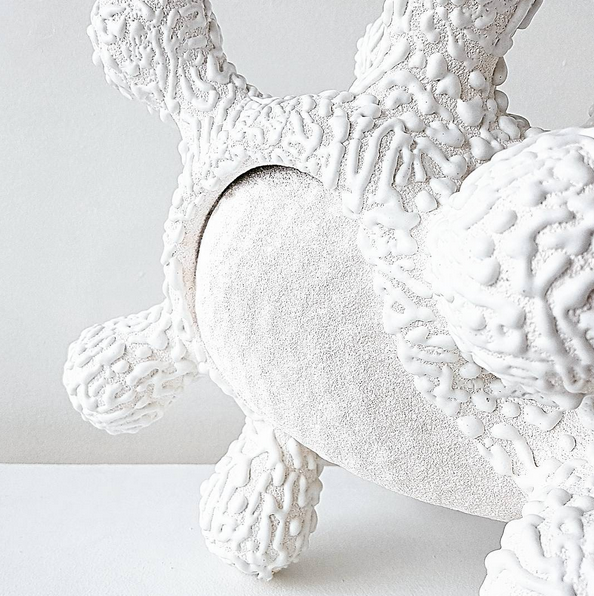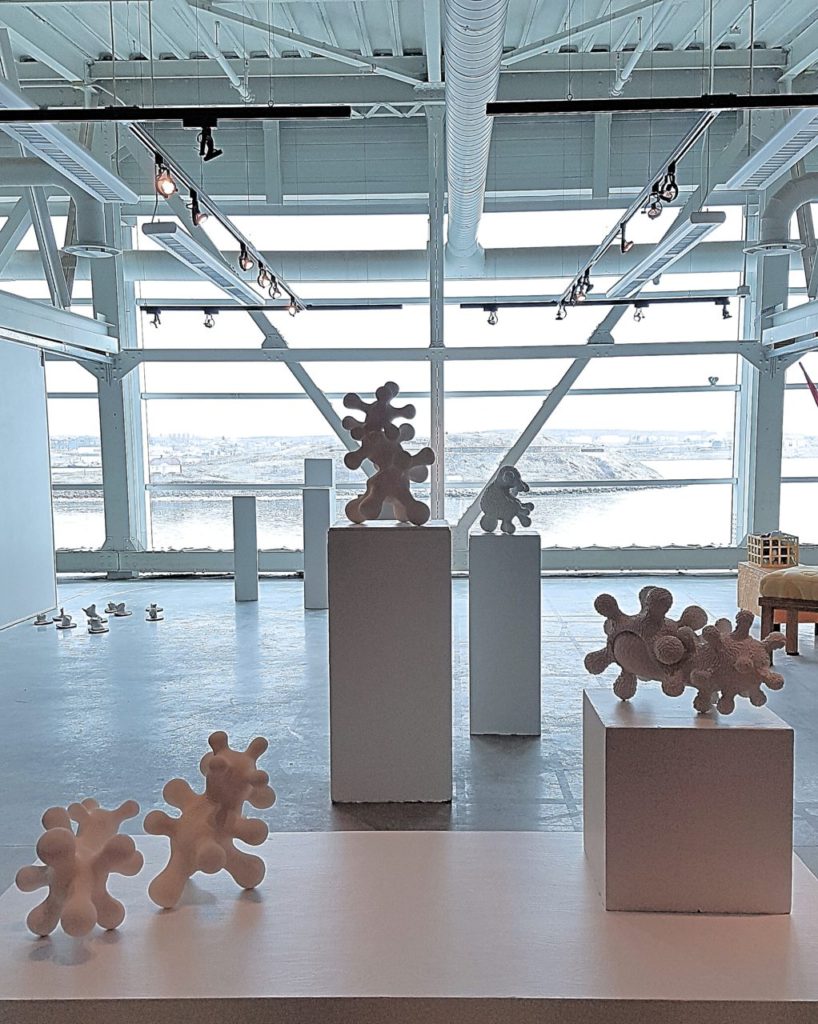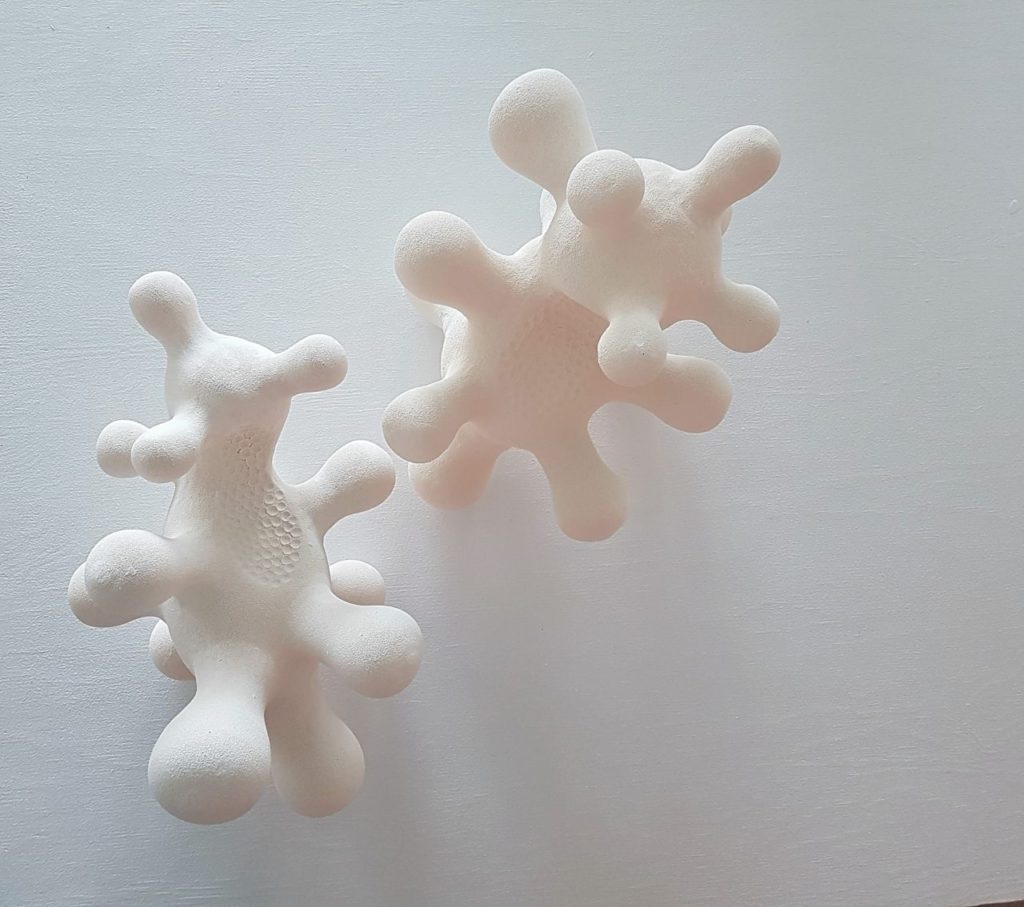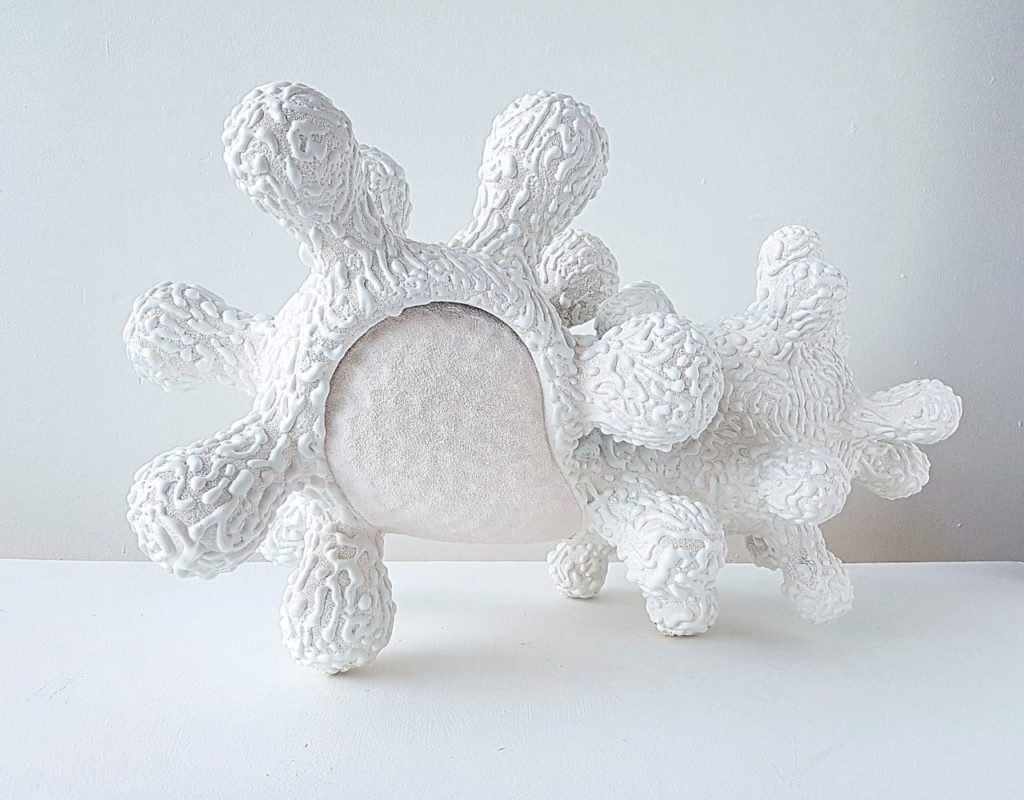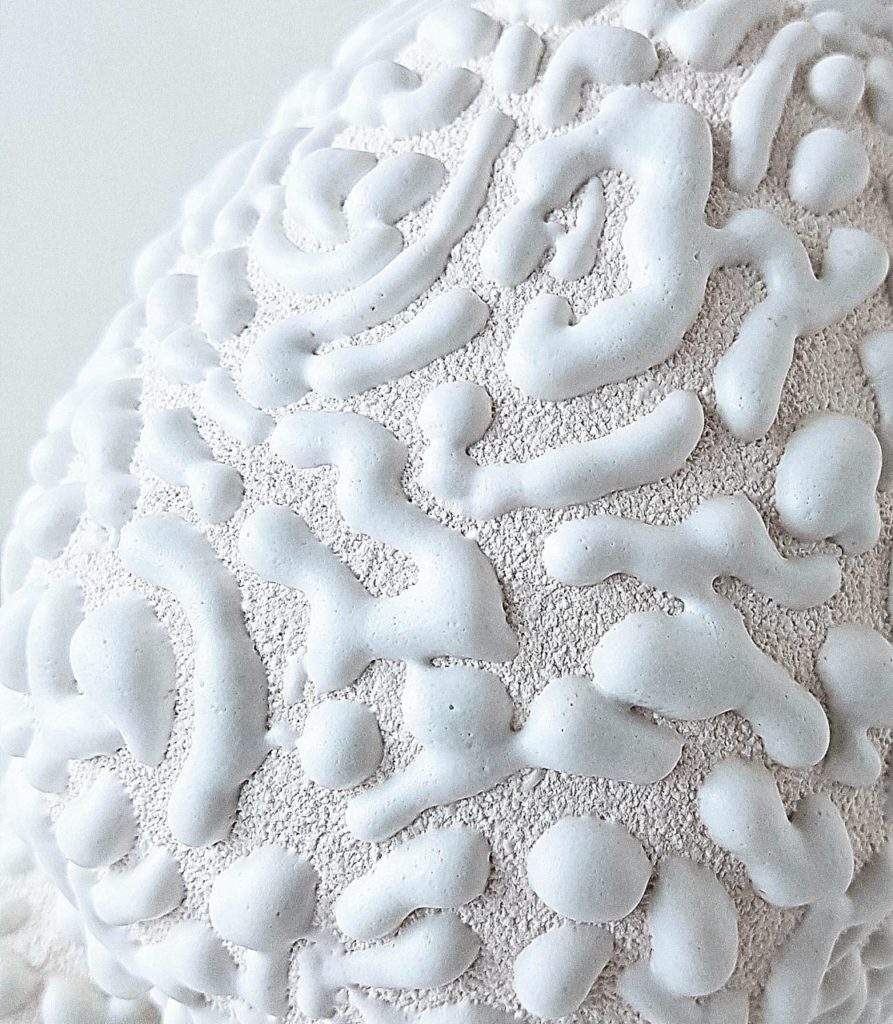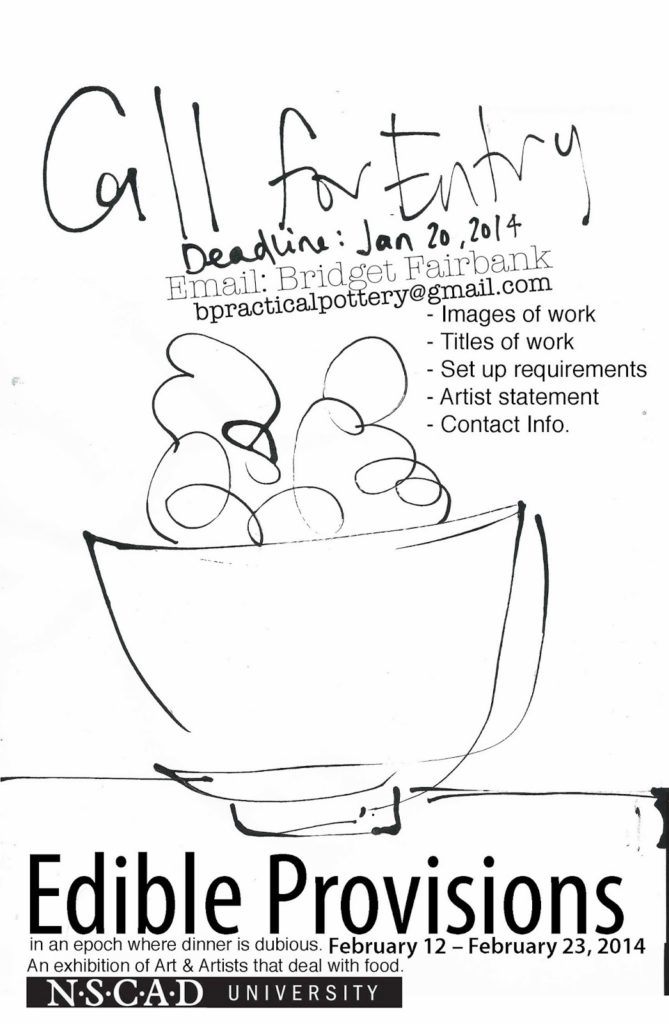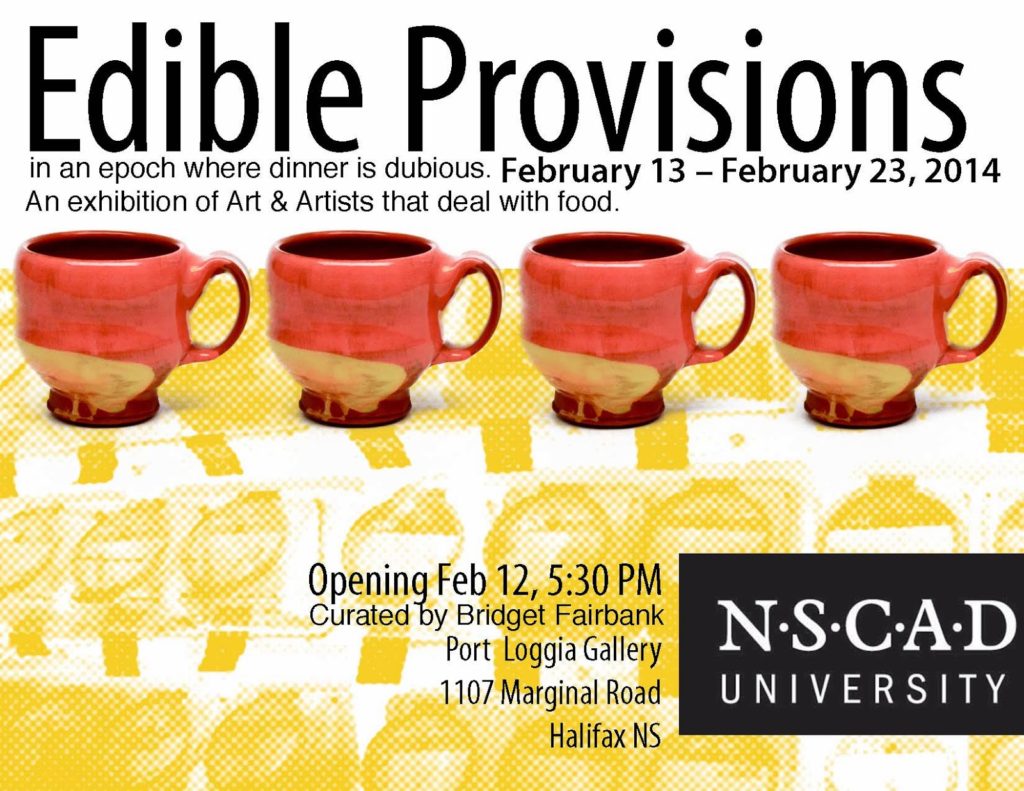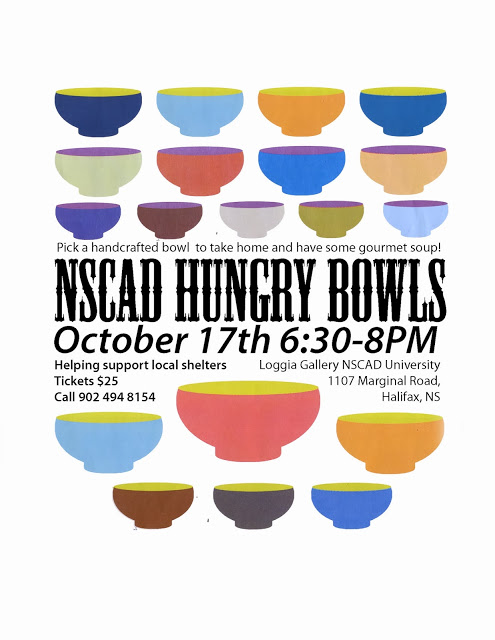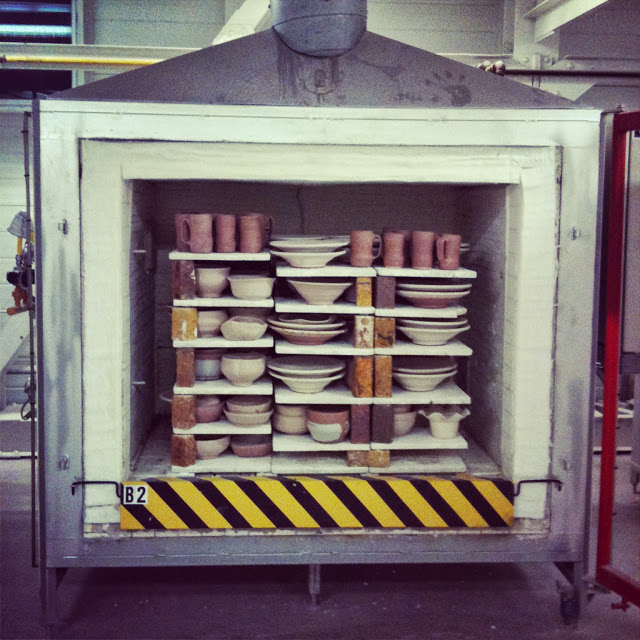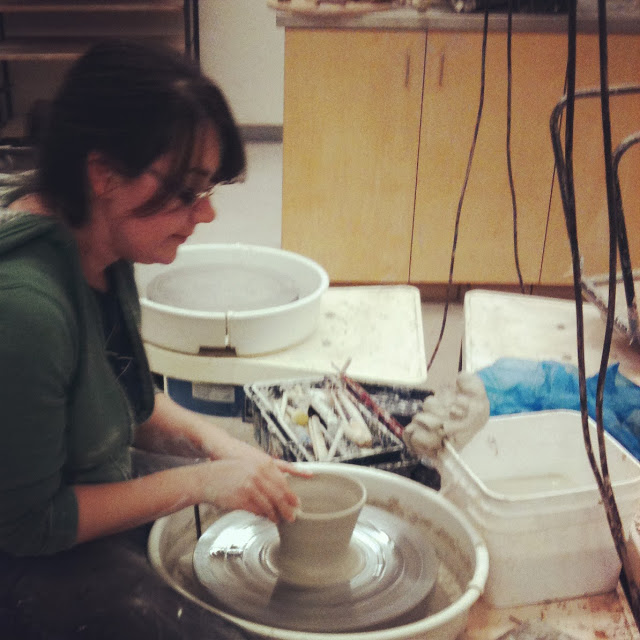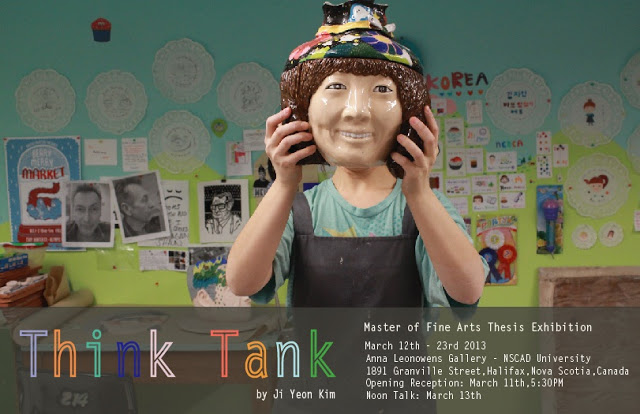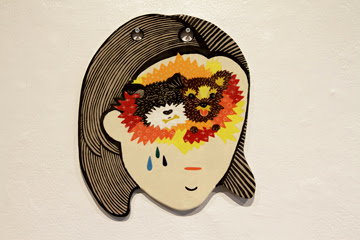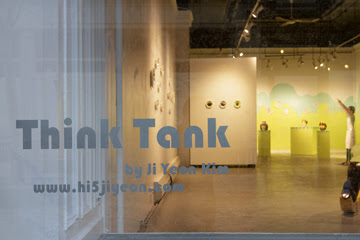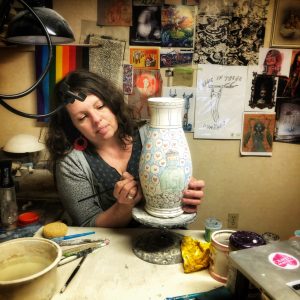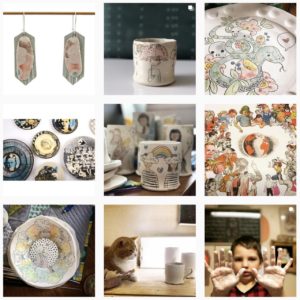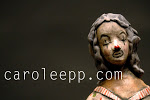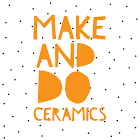SPECIAL CERAMICS STUDY @ NSCAD
WINTER 2017 (January – April)
NSCAD Ceramics continues its dynamic role internationally for
progressive approaches to BFA and MFA studies. The Ceramics Department
is respected for its programming in pottery and contemporary sculpture
issues and more recently its architectural and design investigations,
recognizing the complex relationship between the built environment and
contemporary social and ecological issues.
We are inviting new and returning students to come to NSCAD for the
Winter 2017 semester to try out our new courses in our incredibly
equipped studios.
- You are a student from one of our partner schools studying through our Mobility or Exchange program.
- You are a current ceramics student at a non-exchange-partner school transfering our courses back to your program.
- You are a ceramic artist enrolling as a special student for professional development purposes.
We welcome you to apply for this special Winter 2017 semester (January – April) of ceramics study by November 15.
PROGRAM
The newly revised Ceramics Program offers three streams:
throwing/pottery, hand-building/sculpture and design/mold/digital
fabrication, in order to direct your learning to more particular
outcomes. An expanded offering allows interdisciplinary students to
build a portfolio of ideas in the Ceramics studios. Our topic workshops
offer in-depth approaches on graphic, narrative and technical approaches
to the ceramic surface, figuration, installation, architecture and
tableware.
The program emphasizes craft theory, history and discourse. As such,
NSCAD is committed to researching technologies to support new ceramic
practices combining developments in materials and computer interface 3D
fabricating technologies. Ceramics has mold making facilities, a large
RAM press, extruders, clay mixing facilities, spray booth, fully
equipped glaze lab and 15 kilns, including three state-of-the-art Blaauw
computer controlled gas kilns.
NSCAD ceramics graduates have successfully entered MFA programs such
as Alfred University, University of Florida and RISD, and have become
professors in institutions such as Alberta College of Art and Design,
Alfred University, MICA and Sheridan College.
COURSES
For the full list of courses offered during the Winter 2017 semester, search our online registration system, WebAdvisor.
CERM 3512 Architecture + Ceramics – Neil Forrest
This course examines the intersection of architecture and ceramics.
Ceramics has historically been essential to functional and narrative
capacities of architecture. This course will examine new artistic and
technical potentials for ceramics in contemporary architecture, and
provide a conceptual and theoretical framework to articulate new
relationships Students will work with structured and self-directed
projects and be presented with a range of architectural parameters in
which to develop a responsive practice in a truly interdisciplinary
context. In addition to tiles and other envelope/sheathing forms of
ceramic, students will be challenged to find new environmental
applications and artistic narratives. Architects and designers will
present the contemporary issues of architecture in regards to social,
artistic and engineering needs.
CERM 3513 Art of the Table – Joan Bruneau
The table is the context in which ceramics will define social space.
This course will examine historical and contemporary approaches to
function as it relates to food, society and ceramics. What and how we
eat is never static and this course will dissect social interaction
through objects in the environment of the dinner table. The
organization, display and relationships among ceramic objects create and
define social spaces. Historical form will be part of an equation to
find contemporary form, and tableware will be seen as a tool of social
interaction. Examples from contemporary design and craft will inform
processes in moldmaking, handbuilding and throwing as primary
construction techniques.
CERM 3110 Intermediate moldmaking and digital fabrication- RoryMacDonald
This course develops techniques of slip casting and complex
mold-making for students with prior experience in ceramics. Moldmaking
stands alone as a method of fabrication, but is widely used as a
supportive technique within a studio oeuvre. Molds apply equally to the
typologies of pottery, sculpture and architecture within the medium of
casting slip (liquid clay). Conventional and experimental methods will
help students develop a range of indirect fabrication methods to produce
unique vocabularies. This course exploits the process of slip casting
to amplify design and production methods for all ceramic genres.
Students work in small teams to organize and gas reduction and electric
kilns at midrange using semi porcelains and whitewares.
AHIS 2657 Folk Art – Sandra Alfoldy
This course will explore the complicated history of folk art, its
relationship to main street art, and the importance of folk art to Nova
Scotia’s cultural identity. Folk art is generally understood as
utilitarian, decorative art created in cultural isolation by anonymous,
untrained artists. We will question the role of folk art in our
globalized world and how it compares to outsider art while examining the
extraordinary objects created by ordinary people.
AHIS 4513 Senior Seminar: Craft and Food – Sandra Alfoldy
Craft and food have always been intimately connected. From early
artisanal production out of sheer necessity to the extravagances of the
table in the eighteenth and nineteenth centuries to today’s resurgence
of artisanal foods, this course will explore the morals, manners and
materials of craft and food. The seminar will culminate in a dinner
party.
HOW TO APPLY
MOBILITY / EXCHANGE
If you are a mobility or exchange student at one of our partner
schools, you may apply through your on-campus mobility or exchange
office. We are extending the deadline for application for Ceramics
studies for Winter 2017. Application details are found here. Please contact: [email protected] for more information.
ADVANCED STANDING
If you are currently studying at another art college or university or
you have recently graduated, but wish to enrol for further studies in
our Special Semester of Ceramics, apply as an Advanced Standing student
with your program specialization in Ceramics. Application details are
found here. Please contact: [email protected] for more information.
PROFESSIONAL DEVELOPMENT
If you are a graduate of a ceramics program or a professional ceramic
artist and wish to join our courses to further your professional
development, apply as an Advanced Standing student with your program
specialization in Ceramics. Application details are found here. Please contact: [email protected] for more information.
call for entry: Edible Provisions
a collection of cutting edge work from various Artists working in
various mediums that address how and what we eat today. The works
exemplify the complexities of our eating in an epoch where dinner is
dubious.
has come to my attention that there are many artists making work about
food. These artists are actively questioning how we manufacture, grow,
procure and eat every day. There is a rich history to mine when it comes
to food relations sensual, domestic and industrial. I propose a call to
students and alumni who make such food oriented work for a group
exhibition: Edible Provisions. This past year I have seen ceramic
sculpture meat cuts hanging from rafters, portraits of people’s
fridges, pottery for the seasonal splendor and prints of farm machinery
that beckon questions of Cold War technology- all talk about our current
and crucial relation to food.
NSCAD now Sandra Alfoldy is teaching a seminar on craft and food a
marker of the relevancy of such an exhibition. Dine by Design is this
week, Hungry Bowls the next, Art and Food Activism are linked as ever.
We have the opportunity now to showcase such work going on at NSCAD. Edible Provisions
would bring together the many ideas, experiences and critiques of food
culture into a single exhibition space complicating the food
conversation in a dynamic visual manner.
use of the gallery space is highly dependent on the works submitted and
their individual requirements and group requirements, all will be
managed by me as curator/coordinator and all managed in such a way to
deepen the conversation about food and the facets there in embracing and
showcasing the many opinions we have in regards to food carnivores,
omnivores, vegans and vegetarians, fast foodies, foodies, industrialists
and small scale farmers alike. The intent of the exhibition to make us
think about food.
PortLoggia is an open space gallery that students have access to at
night with out security and in no way will I or NSCAD/AnnaLeonOwnes
Gallery be responsible for damage or theft, the gallery is however
equipped with 24hr video surveillance.
Shipping to and from the gallery will not be subsidized.
“I am very
excited about this show and know that so many of your blog readers make
work while thinking about food. As an odd side project to make the show
more feasible for non-Haligonians I’d be happy to accept mugs from your
readers and mail them a mug of mine in exchange at no cost. That way the
mug is displayed and in the show and becomes part of my collection as a
trade!” – Bridget
NSCAD Hungry Bowls
The potters are busy potting and the kilns are firing for this years’ HUNGRY BOWLS fundraiser at NSCAD. $25 gets you a ticket and a bowl and the awesome feeling that you get by donating to local shelters : )
guest post: Bridget Fairbank of B Practical Pottery Blog
A huge thanks to today’s guest writer, the amazingly talented Bridget Fairbank of B Practical Pottery Blog. I’m sure you all are followers of her blog, but if not, make sure to start! When I saw some of the images from Ji Yeon’s Think Tank exhibition on Bridget’s instagram feed I started begging for more pictures and bugging Bridget for a review. Looks like it was an amazing show and I’m thrilled to read Bridget’s review below.
Review: Ji Yeon’s Think Tank
The subject of this review is Think Tank: A Master of Fine Arts Thesis Exhibition by Ji
Yeon Kim shown at the Anna Leonowen’s Gallery in Halifax N.S. March 12-23 2013 comprising
of delightful ceramic sculptures and functional work dealing with the complexities of being a
South Korean in Canada. Themes of culture shock, fear and adaption run through each work in
the Think Tank, however the show is anything but dark, rather the work is Ji’s joyful
manifestation of overcoming difference with a childlike resilience embodied in wonderment and
playfulness.
 The exhibition is named Think Tank in honor of Ji’s professors Neil Forrest and Rory McDonald. Jars rendered as portraits of all three are the feature of the exhibition (see photo to the left and below) and act as repositories for spectators comments written on doilies. With this action the think tank is ever being replenished and expanded. It is a great example of the interaction and playfulness Ji promotes. The original triad has been pivotal to Ji’s progression and studies at NSCAD University. Coming highly technically skilled from previous training in South Korea and used to working in a constrained environment Ji’ explains, “their personalities are really open and they are whimsical, funny individuals” (interview) their interactions allowed her to experiment and play in all aspecting of thinking and making. A sense of coy play permeates all aspects of Ji’s practice. Ji’s studio at NSCAD, a secretive place you must have the a password to get into (for your information the password is “little monster”, shhh!) “is the gateway to [her] artistic practice; the most important ideas in [her] practice are play, color, culture, language and interaction with people. [Her] work is about more than simple playfulness. It is a ceramic
The exhibition is named Think Tank in honor of Ji’s professors Neil Forrest and Rory McDonald. Jars rendered as portraits of all three are the feature of the exhibition (see photo to the left and below) and act as repositories for spectators comments written on doilies. With this action the think tank is ever being replenished and expanded. It is a great example of the interaction and playfulness Ji promotes. The original triad has been pivotal to Ji’s progression and studies at NSCAD University. Coming highly technically skilled from previous training in South Korea and used to working in a constrained environment Ji’ explains, “their personalities are really open and they are whimsical, funny individuals” (interview) their interactions allowed her to experiment and play in all aspecting of thinking and making. A sense of coy play permeates all aspects of Ji’s practice. Ji’s studio at NSCAD, a secretive place you must have the a password to get into (for your information the password is “little monster”, shhh!) “is the gateway to [her] artistic practice; the most important ideas in [her] practice are play, color, culture, language and interaction with people. [Her] work is about more than simple playfulness. It is a ceramic
investigation into a cultural adventure” (thesis). With this playful and
respectful tone Ji asks us all to take a look at her work and join in
her story, a story such that every traveller knows.
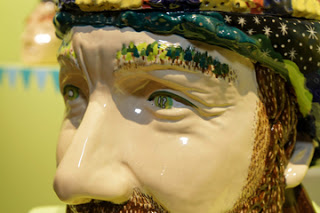
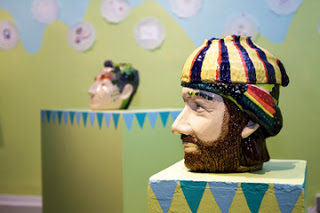
Walking into the exhibition we are faced with a wall painted in undulating light blue and lime green lines of color and adorned with more doilies, Ji’s preferred paper to sketch on. These
bright colors and sketches are translated straight from Ji’s studio space, it is her way of reaching
out to the viewer and an extension of Ji herself, always the bright and cheery artist. The colors
mask the white walls of the gallery not only to comfort us but also Ji. Ji is afraid of the color
white, for in South Korea white is the color of mourning and so tells the story of death.
This fear is actually what led Ji to clay because clay is a warm hue unlike a stark white primed canvas, Ji relaxes when working with the medium. More themes of cultural difference arise as in her artist talk Ji explains how shocking it was to see how Haligonians have old cemeteries in the middle of the city and real estate around them is costly- in Korea ghosts would not be welcoming neighbors. Thus Ji surmises that Canadian ghosts are friendly and ghosts become her mascot in Canada. The three jars we encounter next and sure enough Ji’s self portrait depicts Ji wearing a hat with ghosts on it happily flying around in the night. In her eyes we see drawn a question mark and exclamation mark depicting what every piece in the show communicates. Likewise in McDonald’s portrait shows him dawning his toque, which he always wears, where Ji surmises he keeps all his power and energy and secrets. Forrest’s portrait bares no wrinkles or sign of aging with electric green hair he embodies his youthful demeanor, he has no hat symbolizing his
sharing and blunt nature.
Ji says that her work here is more childish compared to what she would have made in
Korea, her initial language barrier rendered her verbal communication childish and so she began
to artistically communicate using childlike sentimentality. In this way we are reminded that
words aren’t even necessary, exchanges can happen in different ways on many levels. The
participation aspect is new to Ji’s work and came from a happy mistake, a letting go of sorts. The
piece Jay Rider, 2011 is a ceramic rendition of a rocking horse but instead of a horse it is Ji’s dear
friend Jay one is asked to mount.
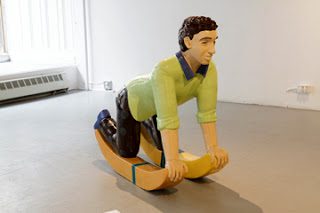 Ji had made a similar piece depicting her father in Korea. When she created Jay in Canada the piece developed a hairline crack on the belly, Ji changed her mind and thought, “maybe everyone can ride his back” (interview). Even knowing the crack was there I paradoxically really wanted to participate, even knowing I could literally be the straw that broke the horses back. This exemplifies just how strong Ji’s work draws the viewer in to engage and enjoy.
Ji had made a similar piece depicting her father in Korea. When she created Jay in Canada the piece developed a hairline crack on the belly, Ji changed her mind and thought, “maybe everyone can ride his back” (interview). Even knowing the crack was there I paradoxically really wanted to participate, even knowing I could literally be the straw that broke the horses back. This exemplifies just how strong Ji’s work draws the viewer in to engage and enjoy.
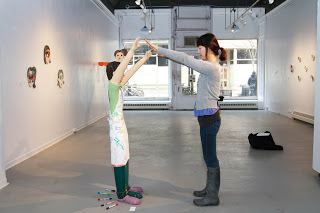 The crack was liberating and freed Ji to make art objects that physically engage the audience such as Whimsy Whimji Bridge, 2013 a play on the song “The London Bridge is Falling Down” a life size sculpture with hands raised to the sky asking you to join in the game.
The crack was liberating and freed Ji to make art objects that physically engage the audience such as Whimsy Whimji Bridge, 2013 a play on the song “The London Bridge is Falling Down” a life size sculpture with hands raised to the sky asking you to join in the game.
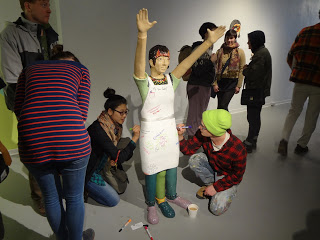 Further more participants are invited to decorate the white apron worn by the figure, an effort to cover up white voids with meaningful bright human interaction. Ji says, “spaces of play are where children (and adults) get to explore, discover, create and imagine” and so with her work she creates that space for us.
Further more participants are invited to decorate the white apron worn by the figure, an effort to cover up white voids with meaningful bright human interaction. Ji says, “spaces of play are where children (and adults) get to explore, discover, create and imagine” and so with her work she creates that space for us.
In the center of the Anna LeonOwens is the three Think Tank jars, Whimsy Whimji Bridge and Jay Rider occupy the middle of the gallery floor and on the walls are tiles and plates. A series entitled Homesick Sometimes, 2013 consists of three self portrait wall tiles narrating Ji’s personal triggers- the cold winter, missing her dogs and culture shock. The pieces are dark yet delightful. Ji uses imagination for comfort and communication. Ji says “life is unpredictable, busy, complicated, and dramatic. It has ups and downs; it can be joyful exultant moments or heartbreaking disappointments… [she] likes to indulge [her]self with daydreams. Sometimes they take [her] away from reality” (thesis) this is something we all feel and need.
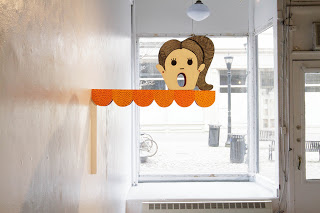 Further along the gallery wall we encounter Aww Oh! Sign, 2013 a wall piece that protrudes out into the room like a shop sign and depicts a shocked Ji, mouth agape. Ji says many things are shocking about Canadian Culture like marijuana and overt sexuality sometimes her only response is “Aww Oh!” and we’ve all had that reaction before!
Further along the gallery wall we encounter Aww Oh! Sign, 2013 a wall piece that protrudes out into the room like a shop sign and depicts a shocked Ji, mouth agape. Ji says many things are shocking about Canadian Culture like marijuana and overt sexuality sometimes her only response is “Aww Oh!” and we’ve all had that reaction before!
 Next two sets of plates entitled Two Missing Plates, 2012 tell of Ji’s forays into Halifax trying to find ingredients to make Korean food and having no such luck. My personal favorite is Meal with a bowl of rice, soup, and side dishes. At last we see the piece I don’t want to wake up at 9AM because Canada’s winter is too cold, 2012 a set of three plates decorated with sleepy bears unwilling to emerge from the warm covers of their beds. Once again a feeling every Canadian knows well.
Next two sets of plates entitled Two Missing Plates, 2012 tell of Ji’s forays into Halifax trying to find ingredients to make Korean food and having no such luck. My personal favorite is Meal with a bowl of rice, soup, and side dishes. At last we see the piece I don’t want to wake up at 9AM because Canada’s winter is too cold, 2012 a set of three plates decorated with sleepy bears unwilling to emerge from the warm covers of their beds. Once again a feeling every Canadian knows well.
Ji’s work is largely autobiographical but anyone who has ever been a foreigner somewhere or spent some time in Canada can relate to the themes put forth by Think Tank and Ji’s personal experience. The exhibition is a profoundly personal one and acts as a reminder to view the world in wonder and stay open minded.
Please take a moment to explore Ji’s past body of work at http://www.hi5jiyeon.com

